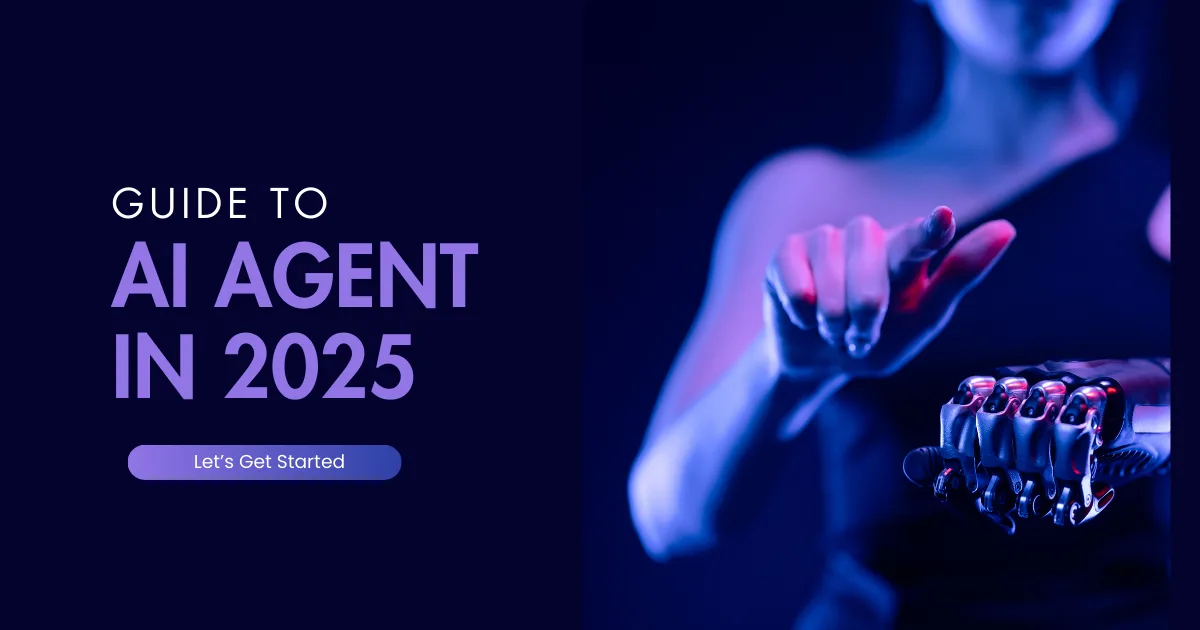The landscape of artificial intelligence has undergone a remarkable transformation with the emergence of AI agents, representing a fundamental shift in how machines interact with and solve real-world problems. These sophisticated systems combine autonomous decision-making capabilities with adaptive learning mechanisms, creating intelligent entities that can perceive, analyze, and respond to complex situations in real-time. Unlike traditional software systems that follow predetermined rules, AI agents possess the ability to learn from experience, adapt to new situations, and make independent decisions based on their understanding of the environment.
The significance of AI agents extends far beyond simple automation. These systems are fundamentally changing how businesses operate, how professionals make decisions, and how industries evolve. In healthcare, AI agents analyze complex medical data to assist in diagnosis and treatment planning. In financial markets, they process vast amounts of information to make split-second trading decisions. In manufacturing, they optimize production processes and predict maintenance needs before equipment failures occur.
- Understanding the Core Foundation of AI Agents
- The Seven-Stage Architecture: Understanding the Operational Framework
- Agentic vs. Non-Agentic AI: Understanding the Fundamental Differences
- Advanced Reasoning Paradigms: The Cognitive Architecture of AI Agents
- Framework Analysis: Understanding Modern AI Agent Development Tools
- Industry Applications: Transforming Business Operations
- Implementation Strategies: A Comprehensive Approach to AI Agent Deployment
- Risk Management: Ensuring Safe and Effective AI Agent Operations
- Future Outlook: The Evolution of AI Agents
Understanding the Core Foundation of AI Agents
To truly grasp the transformative potential of AI agents, we must first understand their fundamental architecture and the principles that govern their operation. AI agents represent a sophisticated evolution in artificial intelligence technology, combining multiple advanced technologies into cohesive, intelligent systems.
The Three Pillars of AI Agent Capabilities
The power of AI agents stems from three fundamental characteristics that set them apart from traditional software systems:
1. Autonomous Decision-Making
AI agents possess the remarkable ability to make independent decisions without continuous human oversight. This autonomy goes far beyond simple if-then rules. Consider a customer service AI agent handling complex billing disputes. The system analyzes multiple factors simultaneously: the customer’s history, similar past cases, company policies, and available solutions. It then crafts personalized responses and takes appropriate actions, such as issuing refunds or escalating to human supervisors when necessary. This level of autonomy enables the agent to handle thousands of cases simultaneously, each with its unique context and requirements.
2. Advanced Contextual Awareness
The contextual awareness of AI agents represents a significant leap forward in machine intelligence. These systems can process and understand multiple types of input simultaneously, creating a comprehensive understanding of their environment. A modern logistics AI agent, for example, doesn’t just look at delivery schedules and routes. It simultaneously analyzes weather patterns, traffic data, vehicle maintenance schedules, driver availability, and customer preferences. This multi-dimensional awareness enables the agent to make sophisticated decisions that account for all relevant factors.
In practice, this means the system might reroute deliveries before a storm hits, adjust schedules to account for traffic patterns, and prioritize time-sensitive shipments – all while maintaining optimal efficiency. This level of contextual understanding would be impossible for human operators to maintain consistently across thousands of deliveries.
3. Continuous Learning Mechanisms
Perhaps the most revolutionary aspect of AI agents is their ability to learn and improve continuously through sophisticated reinforcement learning mechanisms. Unlike traditional software that remains static after deployment, AI agents evolve and adapt based on their experiences and outcomes.
Consider a fraud detection AI agent working in the financial sector. Every transaction it processes, whether fraudulent or legitimate, adds to its knowledge base. When it encounters a new type of fraud attempt, it doesn’t just flag it – it analyzes the pattern, updates its detection algorithms, and shares this knowledge across the entire system. This continuous learning means the agent becomes increasingly sophisticated over time, adapting to new fraud techniques as they emerge.
The Seven-Stage Architecture: Understanding the Operational Framework
The sophisticated operation of AI agents follows a carefully structured seven-stage architecture. Each stage represents a crucial component in the agent’s ability to perceive, process, and respond to its environment effectively. Let’s examine each stage in detail to understand how these components work together to create intelligent, adaptive systems.
Stage 1: Goal Initialization – Setting the Foundation for Success
Goal initialization represents more than simply defining objectives. This stage involves creating a comprehensive framework that guides all subsequent actions and decisions made by the AI agent. When setting goals, the system must understand both explicit and implicit requirements, potential constraints, and desired outcomes.
For example, when an AI agent is tasked with reducing customer support response times by 50%, the goal initialization process involves multiple layers of understanding:
Primary Objective Analysis: The system breaks down the main goal into measurable components, such as average response time, resolution quality, and customer satisfaction metrics.
Constraint Mapping: The agent identifies operational limitations, such as available resources, working hours, and compliance requirements.
Success Criteria Definition: Clear benchmarks are established to measure progress, including both quantitative metrics (response times, resolution rates) and qualitative factors (customer satisfaction scores, resolution quality).
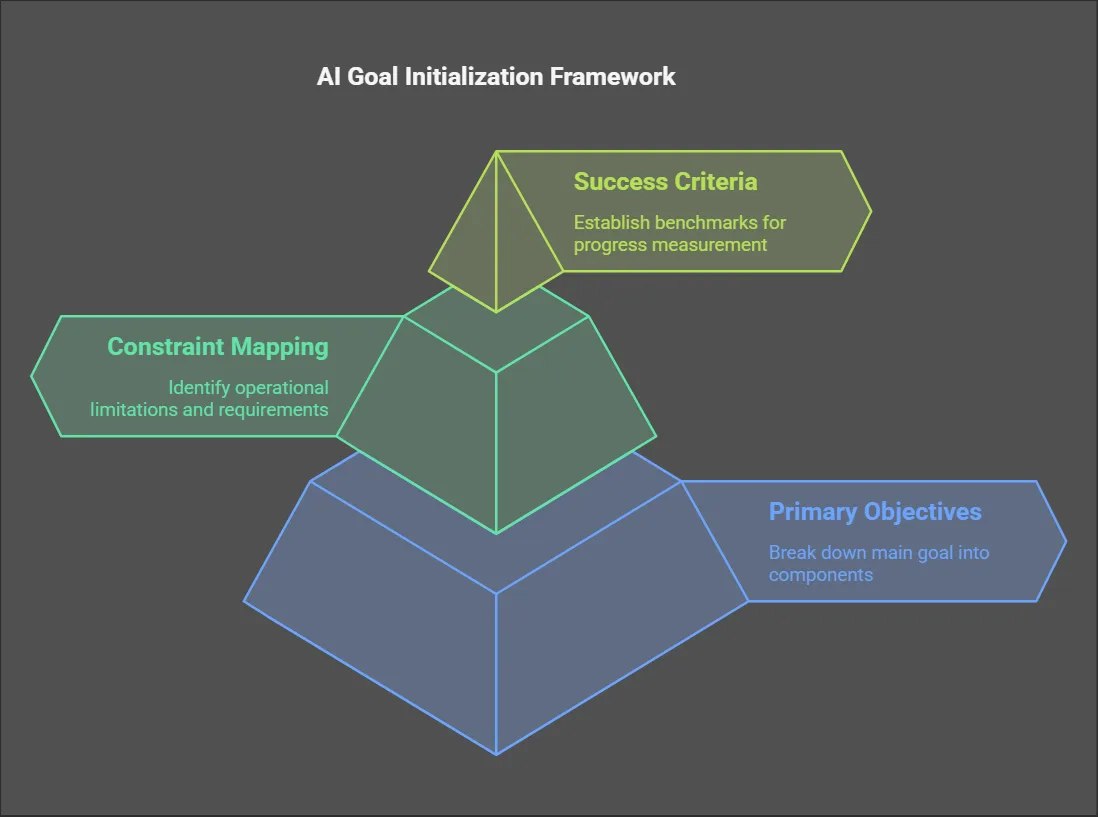
Stage 2: Environmental Perception – Building Comprehensive Awareness
Environmental perception in AI agents goes far beyond simple data collection. This stage involves creating a dynamic, multi-dimensional understanding of the operational environment through sophisticated sensor integration and data processing systems.
In healthcare applications, this might involve:
Patient Data Integration: Real-time monitoring of vital signs through wearable devices, combined with historical medical records and genetic information.
Environmental Factors: Analysis of hospital conditions, including room temperature, humidity, and air quality that might affect patient care.
Staff Availability: Real-time tracking of medical personnel locations and expertise levels to optimize resource allocation.
Each data point is not just collected but contextualized within the broader operational framework, creating a rich, nuanced understanding of the environment.
Stage 3: Data Processing and Contextualization – Creating Meaningful Insights
The data processing stage represents one of the most computationally intensive aspects of AI agent operation. Using advanced transformer-based models, agents convert raw data into actionable insights through multiple processing layers:
Initial Data Cleaning: Raw input undergoes sophisticated preprocessing to remove noise and inconsistencies. For instance, in retail applications, this might involve normalizing customer feedback across different platforms and languages.
Pattern Recognition: Advanced algorithms identify meaningful patterns across multiple data dimensions. A retail AI agent might correlate social media sentiment with sales trends, weather patterns, and economic indicators to predict future demand.
Contextual Integration: Information is synthesized across different domains to create comprehensive insights. For example, a financial AI agent might combine market trends, company financial statements, and global economic indicators to assess investment opportunities.
Stage 4: Decision-Making via Utility Functions – Optimizing Choices
The decision-making process in AI agents involves sophisticated utility functions that evaluate potential actions based on multiple criteria. This stage goes beyond simple cost-benefit analysis to include:
Multi-Parameter Evaluation: Each potential action is assessed across numerous dimensions. For instance, a financial trading agent might evaluate investments based on:
- Expected return calculations
- Risk assessment metrics
- Market volatility indicators
- Historical performance patterns
- Liquidity requirements
- Portfolio balance considerations
Dynamic Weighting: The importance of different factors is adjusted based on current conditions and past outcomes. During market volatility, risk factors might receive higher weighting than potential returns.
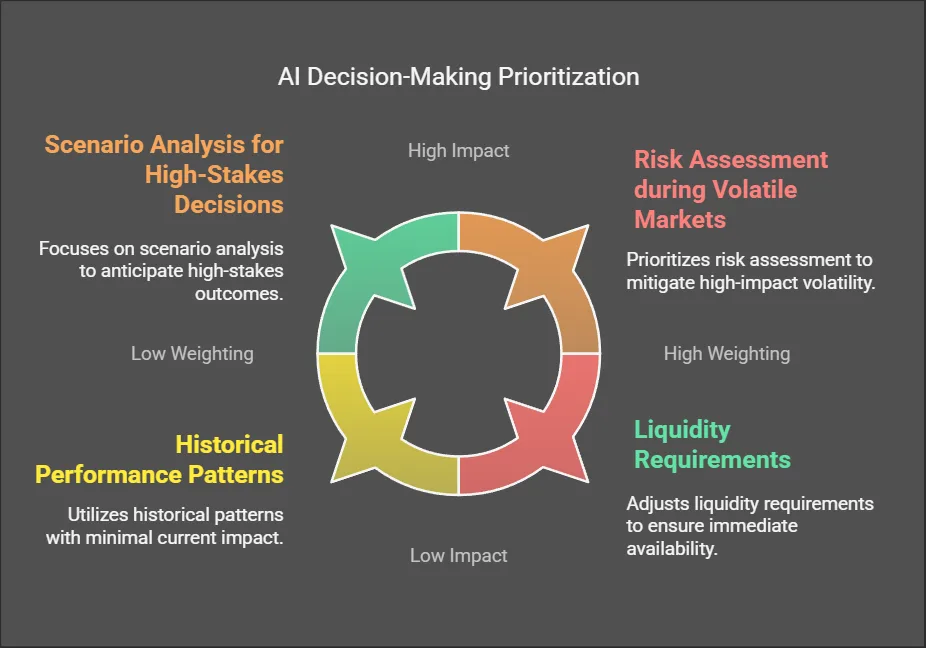
Scenario Analysis: Multiple potential outcomes are simulated and evaluated before making final decisions. This might involve running thousands of simulations to assess the probability of different scenarios.
Stage 5: Action Execution – Implementing Decisions with Precision
Action execution involves more than simply implementing chosen decisions. This stage includes sophisticated monitoring and adjustment mechanisms to ensure optimal outcomes
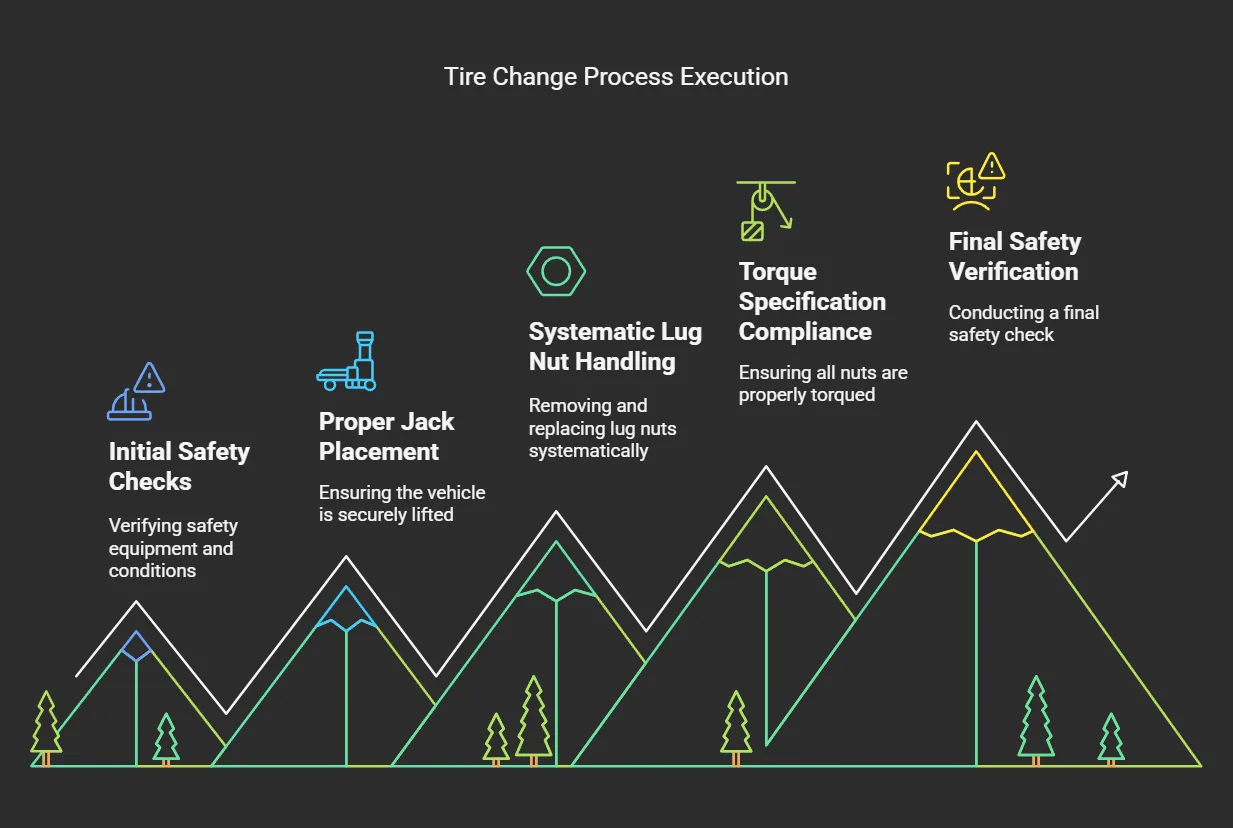
Sequential Implementation: Complex actions are broken down into manageable steps with continuous monitoring at each point. For example, Volkswagen’s tire change AI agent guides users through a precise sequence of actions:
- Initial safety checks and equipment verification
- Proper jack placement and vehicle lifting
- Systematic lug nut removal and replacement
- Torque specification compliance
- Final safety verification
Real-Time Adjustment: The system continuously monitors execution progress and makes necessary adjustments. If a user struggles with a particular step, the agent can provide additional guidance or alternative approaches.
Quality Assurance: Each action includes built-in verification steps to ensure proper completion before moving forward.
Stage 6: Feedback Integration – Learning from Experience
The feedback integration stage represents a crucial learning mechanism that enables AI agents to improve over time. This process involves:
Comprehensive Outcome Analysis: Results are evaluated across multiple dimensions to understand both immediate and long-term impacts. For example, an e-commerce recommendation engine might analyze:
- Immediate conversion rates
- Long-term customer satisfaction
- Average order value changes
- Customer retention metrics
- Cross-selling effectiveness
Performance Optimization: Insights from outcome analysis are used to refine decision-making models and adjust utility functions. This might involve updating algorithmic weights, modifying decision thresholds, or revising evaluation criteria.
Knowledge Base Enhancement: Successful strategies are documented and integrated into the agent’s core knowledge base for future reference.
Stage 7: Adaptive Refinement – Continuous Evolution
The final stage focuses on long-term improvement and adaptation to changing conditions. This involves:
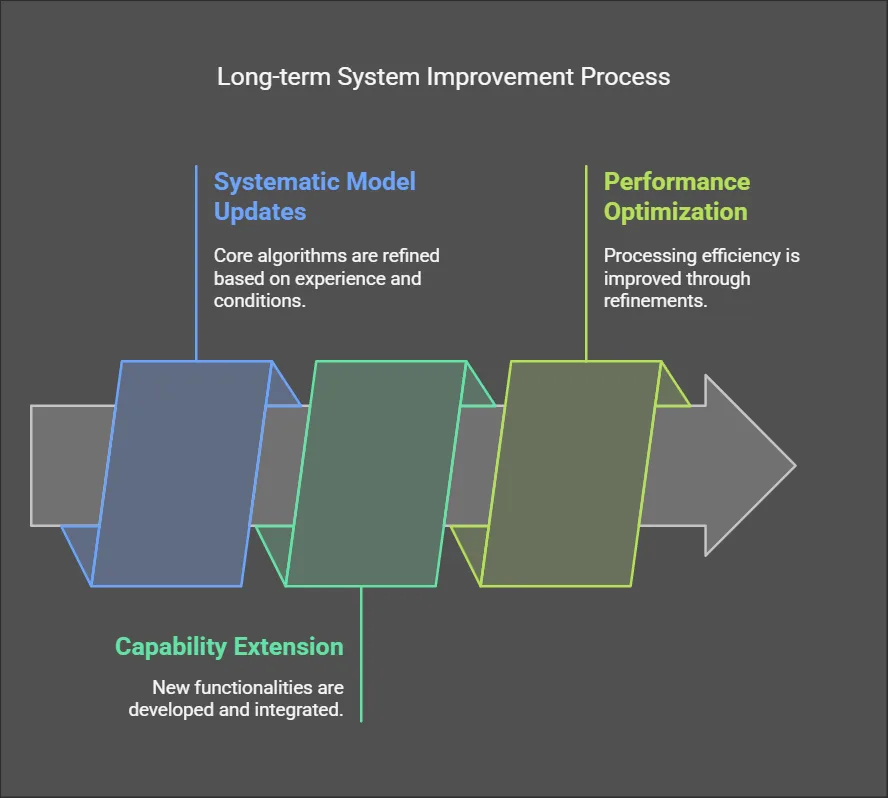
Systematic Model Updates: Core algorithms are regularly refined based on accumulated experience and changing conditions. During the 2024 API crisis, cloud management agents demonstrated this capability by rapidly developing new traffic routing strategies.
Capability Extension: New functionalities are developed and integrated based on identified needs and opportunities. This might involve adding support for new data types or developing more sophisticated analysis capabilities.
Performance Optimization: Processing efficiency is continuously improved through algorithmic refinement and resource optimization.
Agentic vs. Non-Agentic AI: Understanding the Fundamental Differences
The distinction between agentic and non-agentic AI represents a crucial evolution in artificial intelligence technology. To understand this difference, we must examine both traditional AI systems and modern AI agents in detail, exploring how their capabilities and limitations shape their practical applications.
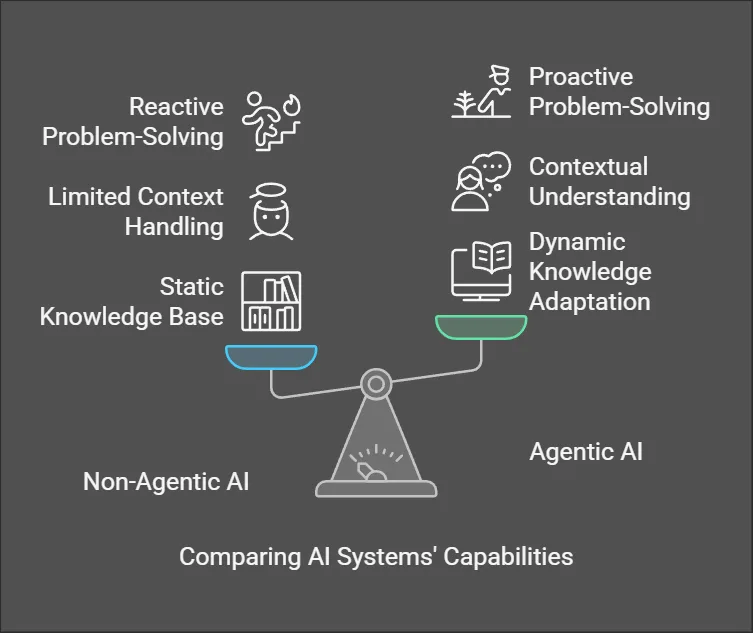
Traditional Non-Agentic AI Systems: Understanding the Limitations
Traditional AI systems, including advanced chatbots and rule-based automation tools, operate within well-defined but ultimately limited parameters. These systems primarily react to specific inputs with pre-programmed responses, even when using sophisticated language models. Consider a traditional customer service chatbot: while it can effectively handle password resets and basic account inquiries, it struggles with complex scenarios that require understanding broader context or maintaining long-term memory of interactions.
The limitations of non-agentic AI become apparent in several key areas:
Static Knowledge Base: Traditional systems rely on information provided during their initial training, lacking the ability to incorporate new knowledge dynamically. When encountering novel situations, these systems often default to generic responses or fail to provide relevant assistance.
Limited Context Understanding: While they may process individual queries effectively, non-agentic systems struggle to maintain context across extended interactions. A customer service chatbot might ask the same questions repeatedly, unable to build upon information already provided.
Reactive Programming: These systems follow predetermined scripts and decision trees, making them inflexible when facing unexpected scenarios. Their responses, while potentially sophisticated, remain fundamentally reactive rather than proactive.
Modern Agentic AI: A Revolutionary Approach
In contrast, modern AI agents represent a fundamental shift in how artificial intelligence systems operate and interact with their environment. These systems demonstrate sophisticated capabilities that transcend traditional limitations:
Proactive Problem-Solving: Consider TechSee’s agentic AI system, which exemplifies this advanced capability. When troubleshooting device issues, it doesn’t simply respond to user queries – it actively analyzes live video feeds, cross-references error codes with known issues, and guides users through complex hardware repairs. This proactive approach involves:
Device Analysis: The system visually identifies device components and potential issues. Contextual Understanding: It considers the user’s technical expertise level and adjusts instructions accordingly. Adaptive Guidance: Instructions are modified in real-time based on user actions and feedback.
Multimodal Reasoning: Modern AI agents excel at combining different types of information to create comprehensive understanding. An insurance claims AI agent demonstrates this capability by:
Visual Analysis: Processing accident scene photographs to assess damage extent Document Processing: Analyzing driver histories and policy documents Environmental Data: Incorporating weather reports and road conditions Historical Context: Comparing similar cases and their outcomes
The system synthesizes all this information to make informed decisions about claim validity and processing.
Advanced Reasoning Paradigms: The Cognitive Architecture of AI Agents
The sophisticated problem-solving capabilities of AI agents stem from advanced reasoning methods that mirror and enhance human cognitive processes. These reasoning paradigms enable agents to tackle complex challenges with unprecedented accuracy and transparency.
Chain-of-Thought (CoT) Processing: Breaking Down Complex Problems
Chain-of-Thought reasoning represents a revolutionary approach to problem-solving in AI systems. This methodology breaks down complex problems into manageable steps, similar to human cognitive processes. Let’s examine how this works in practice:
Mathematical Problem-Solving: Consider how OpenAI’s o1 model approaches complex differential equations:
Initial Analysis: The system first identifies the type of equation and relevant mathematical principles. Step Decomposition: Complex calculations are broken into smaller, verifiable steps. Intermediate Verification: Each step’s result is validated before proceeding. Solution Synthesis: Individual results are combined to reach the final answer.
This transparency in problem-solving allows users to verify the agent’s logic at each step and identify any potential errors in the reasoning chain.
Self-Consistency Chain-of-Thought: Ensuring Reliable Outcomes
Self-consistency approaches take reasoning a step further by generating and evaluating multiple potential solutions to ensure reliability. This process involves:
Multiple Solution Paths: When evaluating loan applications, an AI agent might generate 5-7 different decision trees, each considering various factors:
Income Verification: Analyzing salary documentation, business records, and asset statements Credit Assessment: Evaluating credit scores, payment history, and existing obligations Risk Analysis: Considering market conditions, employment stability, and economic indicators
Solution Comparison: The system then compares these different approaches to identify the most consistent and reliable outcome. This might involve:
Pattern Recognition: Identifying common conclusions across different analysis paths Outlier Detection: Flagging and investigating significant variations in outcomes Confidence Scoring: Assigning reliability scores to different solution paths
Types of AI Agents: A Comprehensive Classification
Understanding the various types of AI agents helps organizations select the most appropriate solutions for their specific needs. Different types of agents excel at different tasks, and many modern systems combine multiple agent types to create more comprehensive solutions.
Decision Logic-Based Classification
Simple Reflex Agents: These agents operate on basic if-then rules but can be highly effective for specific tasks. In financial compliance, a reflex agent might:
Monitor transactions for specific threshold violations Flag suspicious patterns based on predefined criteria Implement immediate response protocols when violations occur
For example, a banking system automatically blocking transactions over $10,000 represents a simple but effective reflex agent implementation.
Model-Based Agents: Understanding Complex State Representations
Model-based agents represent a significant advancement over simple reflex systems by maintaining sophisticated internal models of their environment. These agents create and update detailed representations of how their world works, enabling them to make more informed decisions based on past experiences and predicted future states.
Supply chain management provides an excellent example of model-based agents in action. These systems maintain comprehensive models of entire supply networks, including:
Internal State Modeling: The agent tracks real-time inventory levels across multiple warehouses, monitoring stock quantities, storage conditions, and expiration dates for perishable goods. This information is continuously updated as products move through the supply chain.
External Environment Representation: Beyond internal operations, the agent maintains models of external factors affecting the supply chain. This includes supplier reliability metrics, tracking each supplier’s historical performance in areas such as delivery times, product quality, and responsiveness to urgent orders.
Predictive Capacity: Using these sophisticated models, the agent can anticipate potential issues before they arise. For instance, if a supplier’s recent deliveries show increasing delays, the agent might adjust order timing or identify alternative suppliers to prevent stockouts.
Performance Optimization: The system continuously refines its internal models based on actual outcomes. When predictions don’t match reality, the agent updates its models to improve future accuracy. For example, if seasonal demand patterns shift, the agent adjusts its forecasting models accordingly.
Utility-Based Agents: Maximizing Value Through Complex Decision Making
Utility-based agents represent the most sophisticated category of AI decision-making systems. These agents evaluate multiple possible actions based on complex utility functions that consider numerous factors simultaneously. Smart grid management systems exemplify this sophisticated decision-making process:
Energy Distribution Optimization: The agent constantly evaluates multiple factors to maximize grid efficiency:
- Real-time energy demand patterns across different regions
- Current and predicted weather conditions affecting solar and wind generation
- Grid infrastructure capacity and maintenance schedules
- Energy storage levels and charging/discharging efficiency
- Market pricing fluctuations for different energy sources
Environmental Impact Assessment: The system considers environmental factors in its utility calculations:
- Carbon emissions from different energy sources
- Renewable energy availability and capacity
- Environmental regulations and compliance requirements
- Long-term sustainability goals
Cost Management: Financial considerations are integrated into the utility function:
- Real-time energy market prices
- Transmission costs and losses
- Equipment maintenance and replacement costs
- Peak demand charges and time-of-use rates
Reliability Metrics: The agent prioritizes system stability:
- Grid frequency and voltage stability
- Equipment load balancing
- Backup capacity availability
- Historical reliability data and trends
Framework Analysis: Understanding Modern AI Agent Development Tools
The landscape of AI agent development has evolved significantly, with several sophisticated frameworks emerging to address different aspects of agent creation and deployment. Each framework offers unique capabilities and advantages for specific use cases.
Botpress: Advanced Conversational AI Development
Botpress has established itself as a leading framework for creating sophisticated conversational AI agents. Its success stems from several key features:
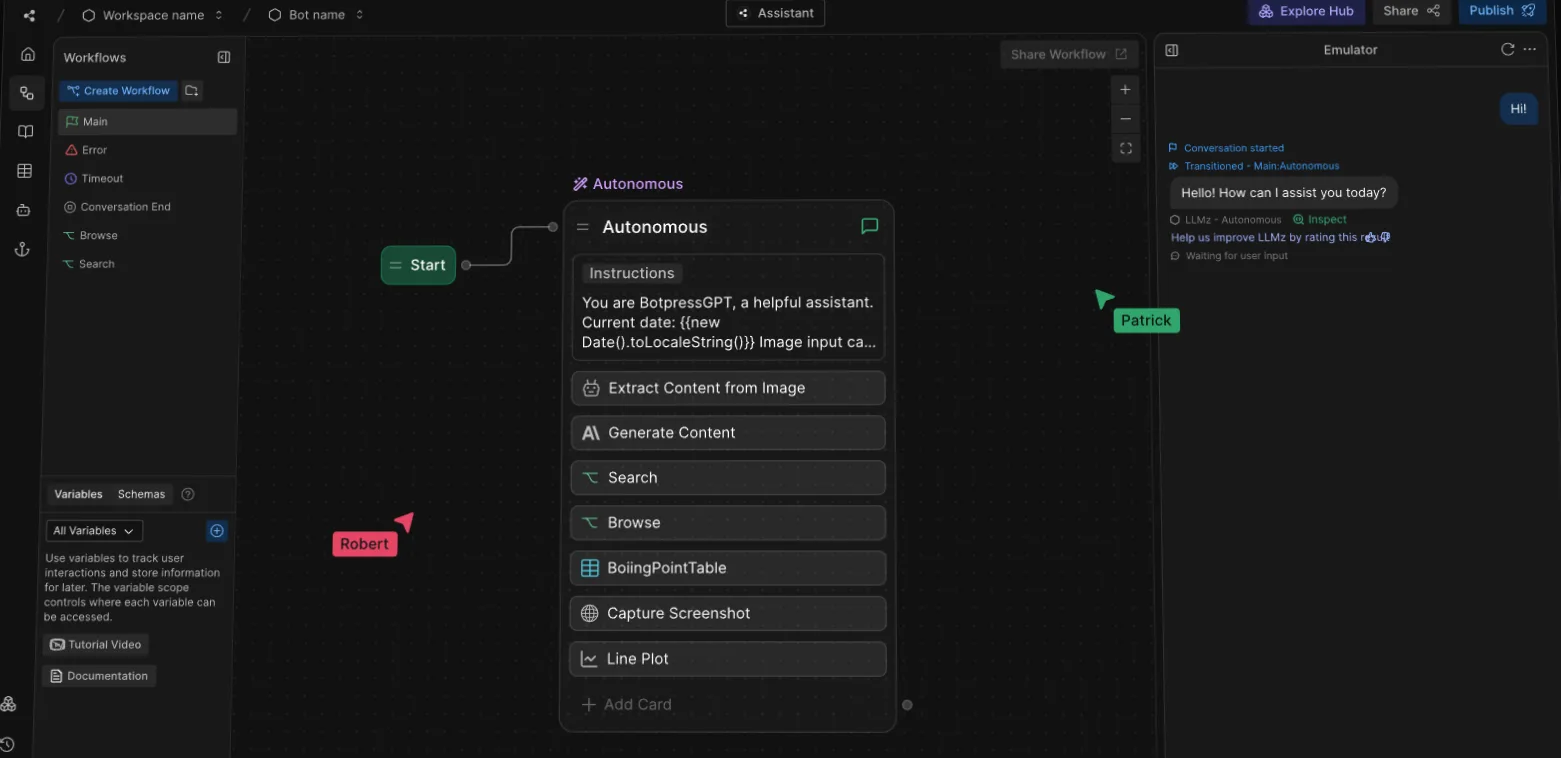
Visual Flow Design: The drag-and-drop interface allows developers to create complex conversation flows without extensive coding. This visual approach enables:
- Rapid prototyping of dialogue structures
- Easy visualization of conversation branches
- Quick implementation of fallback scenarios
- Seamless integration of multiple conversation paths
Natural Language Processing Capabilities: Botpress includes advanced NLP features:
- Multi-language support with automatic language detection
- Intent recognition with confidence scoring
- Entity extraction and validation
- Contextual understanding across conversation turns
Integration Framework: The platform supports numerous external service connections:
- Payment processing through Stripe and PayPal
- Customer relationship management via Salesforce
- Support ticket systems like Zendesk
- E-commerce platforms including Shopify
Real-World Application: E-commerce businesses using Botpress have reported significant improvements in customer service efficiency:
- 40% reduction in support tickets
- Automated handling of order tracking and returns
- Improved customer satisfaction through faster response times
- Reduced operational costs through automation
RASA: Open-Source Flexibility for Custom Solutions
RASA stands out for its open-source architecture and flexibility in creating custom machine learning pipelines. Its framework provides:
Customizable ML Pipeline: Developers can modify every aspect of the natural language understanding process:
- Custom entity extractors for specialized domains
- Tailored intent classification algorithms
- Domain-specific training data incorporation
- Flexible model architecture selection
Healthcare Implementation Example: A major hospital system utilized RASA to create a HIPAA-compliant triage agent:
- Secure patient data handling
- Symptom analysis and severity assessment
- Appointment scheduling optimization
- Emergency response prioritization
The system demonstrated remarkable effectiveness in:
- Reducing wait times for urgent cases
- Improving resource allocation
- Maintaining regulatory compliance
- Enhancing patient experience
LangGraph: Advanced Knowledge Processing
LangGraph specializes in knowledge graph creation and traversal, making it ideal for research and analysis applications:
Knowledge Representation: The framework excels at:
- Creating semantic relationships between concepts
- Identifying hidden connections in large datasets
- Maintaining complex hierarchical structures
- Supporting dynamic knowledge updates
Research Application: In pharmaceutical research, LangGraph enables:
- Analysis of thousands of research papers
- Identification of potential drug interactions
- Discovery of new therapeutic applications
- Connection of disparate research findings
CrewAI: Orchestrating Multi-Agent Systems
CrewAI represents a significant advancement in multi-agent system management, providing sophisticated tools for coordinating multiple AI agents working together. This framework has revolutionized how organizations handle complex, interconnected tasks that require multiple specialized agents working in harmony.
The framework’s orchestration layer enables seamless coordination between different types of agents. In logistics operations, for example, CrewAI manages the intricate dance between delivery drones and warehouse inventory systems. When a customer places an order, the system coordinates multiple agents:
The inventory management agent first confirms product availability and optimal warehouse location. This agent maintains real-time inventory counts and predicts restocking needs based on historical data and current trends. It communicates with suppliers automatically when stock levels approach predetermined thresholds.
The route optimization agent then calculates the most efficient delivery path, taking into account factors such as weather conditions, air traffic, and delivery time windows. This agent continuously updates routes based on real-time conditions, ensuring optimal resource utilization.
The drone fleet management agent coordinates multiple delivery vehicles, managing aspects such as battery levels, maintenance schedules, and load balancing. It ensures smooth handoffs between drones when longer routes require multiple vehicles.
The customer communication agent keeps customers informed of their delivery status, providing real-time updates and handling any queries or concerns that arise during the delivery process. This agent learns from customer interactions to improve communication effectiveness over time.

LlamaIndex: Revolutionizing Data Access and Analysis
LlamaIndex has transformed how organizations interact with their data by creating a unified interface for both structured and unstructured information. This framework excels at making complex data accessible through natural language queries, enabling more intuitive data exploration and analysis.
Financial analysts using LlamaIndex can seamlessly query vast collections of earnings reports, market analyses, and regulatory filings. The system processes these queries through several sophisticated layers:
Data Integration Layer: The framework first unifies data from multiple sources, including:
- SQL databases containing quantitative financial metrics
- PDF reports with qualitative market analysis
- Real-time market data feeds
- News articles and press releases
- Social media sentiment data
Natural Language Processing: LlamaIndex converts natural language questions into structured queries that can access this unified data layer. An analyst might ask, “How have profit margins in the tech sector changed over the last three quarters?” The system then:
- Identifies relevant financial metrics and timeframes
- Locates appropriate data sources
- Performs necessary calculations
- Presents results in an easily digestible format
Context Preservation: The system maintains context across multiple queries, allowing for follow-up questions and deeper analysis. After the initial query about profit margins, an analyst might ask, “Which companies showed the most improvement?” The system understands this question in the context of the previous analysis.
Industry Applications: Transforming Business Operations
The impact of AI agents extends across numerous industries, fundamentally changing how organizations operate and deliver value. Let’s examine some of the most significant transformations in detail.
Healthcare Revolution: Enhancing Patient Care and Operations
In healthcare, AI agents have created unprecedented improvements in both patient care and operational efficiency. The Cleveland Clinic’s implementation of diagnostic AI agents demonstrates the remarkable potential of these systems:
Diagnostic Accuracy: The system achieves 94% accuracy in analyzing MRI scans, surpassing traditional analysis methods in both speed and reliability. This high accuracy rate comes from:
- Advanced image processing algorithms that can detect subtle anomalies
- Continuous learning from new cases and outcomes
- Integration with comprehensive patient health records
- Cross-reference capabilities with global medical databases
Treatment Personalization: AI agents have transformed how healthcare providers develop treatment plans by:
- Analyzing genetic markers to predict treatment effectiveness
- Cross-referencing patient data with clinical trial outcomes
- Monitoring real-time patient responses to adjust treatments
- Predicting potential complications before they occur
Operational Efficiency: Beyond direct patient care, AI agents optimize hospital operations through:
- Intelligent scheduling systems that reduce wait times
- Resource allocation optimization for equipment and staff
- Automated supply chain management for medical supplies
- Predictive maintenance for critical medical equipment
Financial Services Transformation: Enhancing Market Intelligence and Risk Management
The financial sector has embraced AI agents to handle increasingly complex market dynamics and regulatory requirements. Morgan Stanley’s implementation of AI agents in wealth management showcases several groundbreaking capabilities:
Portfolio Management: AI agents continuously monitor and adjust investment portfolios by:
- Analyzing real-time market data across multiple asset classes
- Evaluating global economic indicators and news events
- Assessing individual client risk tolerances and investment goals
- Implementing sophisticated rebalancing strategies
Fraud Detection: Visa’s advanced AI system processes over 12 million suspicious transactions monthly by analyzing:
- Historical transaction patterns
- Geographic location data
- Device identification information
- Behavioral biometrics
- Merchant risk profiles
Educational Innovation: Transforming Learning Through AI Agents
The education sector has experienced a profound transformation through the implementation of AI agents, with systems like Khan Academy leading the way in personalizing learning experiences. These sophisticated educational agents have revolutionized how students learn and how educators teach.
Adaptive Learning Systems: Modern educational AI agents create truly personalized learning experiences by continuously analyzing student performance and adapting instruction accordingly. When a student interacts with the system, the AI agent performs multiple simultaneous analyses:
Knowledge Assessment: The system begins by evaluating the student’s current understanding across different subject areas. This goes beyond simple right/wrong scoring to include analysis of problem-solving approaches, time spent on different types of questions, and patterns in mistakes. For instance, in mathematics, the agent might recognize that a student struggles specifically with fraction multiplication but excels at addition and subtraction.
Learning Style Identification: Through careful analysis of student interactions, the agent determines optimal learning approaches for each individual. Some students might respond better to visual explanations, while others learn more effectively through practical examples or step-by-step written instructions. The system adjusts its teaching methods accordingly.
Progress Monitoring: The agent tracks student progress across multiple dimensions, including concept mastery, learning speed, and areas requiring additional support. This monitoring happens in real-time, allowing for immediate adjustments to the learning path when needed.
Customized Content Generation: Based on its analysis, the system creates personalized learning materials tailored to each student’s needs. For example, when teaching a new concept, the agent might:
- Generate practice problems at the appropriate difficulty level
- Create examples relating to the student’s interests
- Provide supplementary materials in the preferred learning style
- Adjust the pace of instruction based on comprehension levels
Implementation Strategies: A Comprehensive Approach to AI Agent Deployment
Successfully implementing AI agents requires a carefully planned approach that considers technical, organizational, and human factors. Organizations must follow a structured methodology to ensure successful integration and adoption of AI agent technologies.
Development Process Framework: The implementation journey begins with a clear roadmap that guides the entire process:
Initial Assessment Phase: Understanding the current state of operations, identifying pain points, and determining specific areas where AI agents can provide the most value. This involves detailed analysis of existing processes, data availability, and potential impact areas.
Tool Selection and Architecture Planning: Choosing appropriate frameworks and tools based on specific requirements. For instance, a customer service implementation might combine Botpress for conversation management with custom analytics tools for performance monitoring.
Data Integration Strategy: Creating a comprehensive plan for connecting all necessary data sources. This might include:
- Identifying required data feeds and access methods
- Establishing data cleaning and normalization procedures
- Setting up real-time data streaming capabilities
- Creating backup and redundancy systems
Training and Deployment Approach: Developing a structured process for training AI agents and introducing them into production environments:
- Starting with controlled pilot programs
- Gradually expanding capabilities and responsibility
- Maintaining parallel systems during transition periods
- Establishing clear success metrics and evaluation criteria
Risk Management: Ensuring Safe and Effective AI Agent Operations
The implementation of AI agents brings various risks that must be carefully managed through comprehensive risk mitigation strategies. Understanding and addressing these risks is crucial for successful deployment.
Over-Reliance Risk: The case of the European bank that lost $2M due to misclassified loan applications serves as a crucial lesson in the importance of balanced implementation. To prevent similar issues, organizations should:
Implement Robust Validation Systems:
- Establish multi-layer verification processes for critical decisions
- Create clear escalation paths for uncertain cases
- Maintain human oversight for high-stakes operations
- Regular audit of automated decision outcomes
Data Privacy Protection: In healthcare and other sensitive sectors, protecting private information requires sophisticated approaches:
Federated Learning Implementation:
- Keeping sensitive data within secure local environments
- Training models using distributed computing approaches
- Implementing strict data access controls
- Regular security audits and updates
Bias Prevention and Monitoring: Addressing potential bias in AI systems requires continuous attention and proactive measures:
Comprehensive Fairness Protocols:
- Regular auditing using sophisticated tools like IBM’s AI Fairness 360
- Diverse training data verification
- Ongoing monitoring of decision patterns
- Proactive bias testing and correction
Future Outlook: The Evolution of AI Agents
As we look toward the future, AI agents continue to evolve, bringing new capabilities and opportunities across industries. Current trends and developments suggest several key directions for future growth:
Integration and Interconnectivity: AI agents are becoming increasingly sophisticated in their ability to work together and share information. Future systems will likely demonstrate even greater capabilities in:
- Cross-platform coordination
- Multi-agent problem solving
- Distributed intelligence networks
- Adaptive learning across agent networks
Enhanced Cognitive Capabilities: The next generation of AI agents will likely show significant improvements in:
- Natural language understanding
- Contextual awareness
- Emotional intelligence
- Complex problem-solving abilities
Industry-Specific Evolution: Different sectors will see specialized developments:
- Healthcare: More sophisticated diagnostic and treatment planning systems
- Finance: Advanced risk assessment and market prediction capabilities
- Education: Highly personalized learning experiences
- Manufacturing: Improved process optimization and predictive maintenance
The transformation brought about by AI agents represents a fundamental shift in how organizations operate and deliver value. Success in this new landscape requires a balanced approach that combines technological innovation with careful consideration of implementation strategies and risk management.
Organizations implementing these technologies report efficiency gains between 30% and 50%, while individual developers find success creating specialized agents for niche applications. The key to successful implementation lies in:
- Starting with well-defined, manageable projects
- Maintaining robust feedback loops
- Ensuring proper governance throughout the process
- Continuously monitoring and adjusting deployment strategies
As we move forward, the role of AI agents in business and society will only grow more significant. Organizations that effectively implement these technologies while maintaining appropriate safeguards will find themselves well-positioned for success in an increasingly automated world.
How do AI agents differ from traditional AI systems?
AI agents differ from traditional AI systems by their ability to make autonomous decisions, continuously learn from experience, and maintain contextual awareness. Unlike rule-based AI, which follows predefined instructions, AI agents adapt to new situations, process multiple data sources in real-time, and proactively solve problems. For example, a financial AI agent can detect fraud patterns in transactions and adjust its detection mechanisms based on new fraud techniques, whereas traditional AI would require manual updates.
How do AI agents enhance business efficiency?
AI agents optimize business efficiency by automating complex decision-making processes, analyzing large datasets in real-time, and adapting to changing market conditions. In logistics, AI agents predict delivery delays by integrating weather, traffic, and inventory data, enabling proactive rerouting. In finance, they manage investment portfolios by analyzing economic indicators, news sentiment, and market trends. By reducing human intervention in routine but critical tasks, businesses experience increased productivity and reduced operational costs.
Can AI agents replace human decision-making?
AI agents complement, rather than replace, human decision-making by providing data-driven insights, automating repetitive tasks, and reducing cognitive overload. In healthcare, AI agents assist doctors by analyzing medical images and patient records to suggest potential diagnoses, but the final decision remains with the physician. Similarly, in cybersecurity, AI agents detect and respond to threats faster than humans but rely on security professionals for handling complex attack scenarios.
What are the risks of implementing AI agents?
Implementing AI agents presents challenges such as data privacy concerns, biased decision-making, over-reliance on automation, and security vulnerabilities. If an AI agent in a financial institution misclassifies a transaction due to biased training data, it could lead to incorrect fraud detection and customer dissatisfaction. To mitigate these risks, organizations must establish rigorous auditing processes, maintain human oversight for critical decisions, and ensure transparent AI operations.
How do AI agents continue learning after deployment?
AI agents learn continuously through feedback loops, reinforcement learning, and real-time data updates. A customer service AI agent refines its responses by analyzing customer interactions, identifying successful resolutions, and adjusting its language model accordingly. Similarly, a predictive maintenance AI agent in manufacturing learns from equipment performance data, recognizing patterns that indicate potential failures and improving its predictive accuracy over time.
